New buoy to help discover ‘what’s out there’ in Lake Michigan

Courtesy Photo The original Windsentinel bouy off Vancouver Island during the initial sea trials. The mesh around the top of the bouy is to keep the sea lions off.
Apr 4, 2011
The Michigan Alternative and Renewable Energy Center at Grand Valley State University is about to embark on a three-year project to help to better understand the Great Lakes.
The project will send a specially-made buoy to different parts of Lake Michigan to collect data.
MAREC director Arn Boezaart said the wind assessment study will be a partnership with other universities and will use new technology to collect various types of wind data.
“What we’re going to be doing in partnership with the University of Michigan and Michigan State University is we’re going to go offshore into Lake Michigan and evaluate wind resources and wind speeds and other wind related data and do it in a real time hub height sort of fashion, and we’re going to do this using a brand new laser technology that has never been used for that purpose before,” he said.
Along with wind data, other types of data will be collected, said Jim Edmonson, project manager for the wind assessment study.
“There are at least a dozen instruments on the buoy that measure wind and wave heights and weather data, currents in the lake, all kinds of stuff,” he said.
The buoy, called the WindSentinel, was made by AXYS Technologies, Inc., of Sidney, British Columbia, and will be deployed in September.
Before the project could get underway, MAREC needed federal approval to put the buoy in Lake Michigan, and Edmonson said several permits were needed.
“We need one from the Michigan Department of Natural Resources and the U.S. Army Corp. of Engineering and from the U.S. Coast Guard,” he said.
To help with funding, the project received $3.1 million in grants and research funds.
Boezaart said over the course of three years the buoy will be placed in different areas of the lake to collect data.
“We want to go to three different locations in Lake Michigan to capture data sets for each of those different points,” he said. “This fall, if everything goes according to plan, the buoy will be deployed close to shore in the Muskegon region someplace – perhaps four miles out. The year after that, the buoy will spend the season in the middle of Lake Michigan – the mid-lake plateau – and that will provide a whole different set of data. And then the third year after that, it will come back into a closer to shore location – perhaps six miles out – but that exact location still has to be worked out.”
The buoy will be unique because unlike a meteorological tower, which is fixed in place, the buoy will be mobile and more flexible, so it will be able to collect different types of data.
According to a GVSU press release, once the data is collected, it will be sent to the Padnos College of Engineering and Computing to be evaluated and analyzed by researchers. The data will then leave GVSU and be sent to Michigan State and the University of Michigan for further analysis.
Possible outcomes of the research would be to see if wind farms are an effective form of energy production for Michigan and to find out what kind of animals actually live out in the lake.
“I think we’ll get a beginning understanding about the resource of Lake Michigan in terms of wind and what’s out there,” he said. “There will be a lot of new environmental information learned about the Lake Michigan Environment.”





















